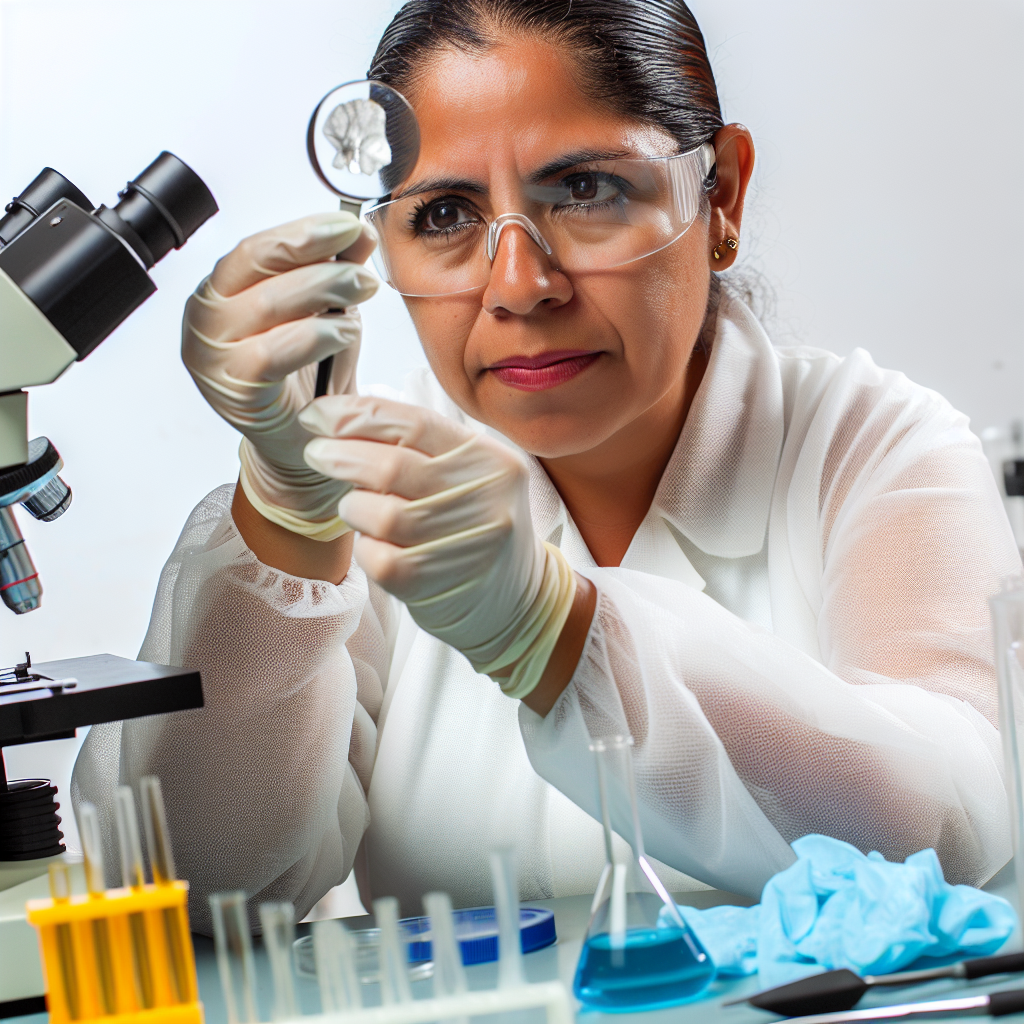Forensic Science Overview
Forensic science involves the application of scientific techniques to solve crimes.
This practice helps identify suspects and exonerate the innocent.
Technological advances play a crucial role in enhancing the capabilities of forensic science.
These innovations provide new tools and methods for investigation.
Improved Analytical Techniques
New technologies such as DNA analysis revolutionize forensic investigations.
Fingerprint identification and facial recognition also enhance accuracy.
These techniques enable investigators to link evidence to individuals.
The result is a higher degree of accuracy leading to successful prosecutions.
Enhanced Evidence Collection
Advancements in crime scene investigation tools improve evidence collection.
Tools such as 3D scanners and UV light sources help experts.
These advancements help preserve evidence effectively and reduce contamination risks.
Digital Forensics
The rise of digital technology has created a new forensic science field.
This field, called digital forensics, aids in criminal investigations.
Experts use specialized tools to recover data from electronic devices.
Predictive Analytics
Technological advances enable the use of predictive analytics in forensic science.
By analyzing data patterns, investigators can predict criminal behavior.
This allows them to prevent crimes before they occur.
Implications of Technological Advances
Technological advances have significantly improved the field of forensic science.
These innovations enhance the accuracy, efficiency, and effectiveness of investigations.
Continual improvement of forensic tools aids investigators working to deliver justice.
Transform Your Career Today
Unlock a personalized career strategy that drives real results. Get tailored advice and a roadmap designed just for you.
Start NowOverview of traditional forensic methods:
- Description of fingerprint analysis
- Explanation of DNA profiling
- Mention of ballistics and trace evidence analysis
Forensic science has long been relied upon to solve crimes and bring justice to victims.
Traditional forensic methods have played a crucial role in criminal investigations.
They help law enforcement agencies identify suspects and gather evidence to support criminal cases.
Let’s take a closer look at some of the key traditional forensic techniques that have been widely used in the past.
Description of fingerprint analysis
Fingerprint analysis is one of the oldest and most reliable methods of identification in forensic science.
Every person has a unique set of ridge patterns on their fingertips.
This uniqueness makes fingerprints a valuable tool in linking suspects to crime scenes.
Forensic experts use specialized techniques to lift and analyze latent prints left behind on surfaces.
These surfaces can include glass, metal, or paper.
By comparing these prints with a database of known prints, investigators can establish a link between a suspect and a crime.
Explanation of DNA profiling
DNA profiling, also known as DNA fingerprinting, revolutionized forensic science.
It does so with its unparalleled accuracy and reliability.
By analyzing specific regions of an individual’s DNA, forensic scientists can create a genetic profile unique to that person.
This profile can then be compared to DNA evidence collected at a crime scene.
It helps determine whether a suspect was present.
DNA profiling has become a cornerstone of modern forensic investigations.
It plays a significant role in exonerating innocent individuals and convicting perpetrators with scientific certainty.
Mention of ballistics and trace evidence analysis
Ballistics analysis involves the examination of firearms, ammunition, and related evidence.
This examination links a weapon to a crime.
Showcase Your Business Today
Reach thousands of readers actively exploring professional services. Publish your business profile and grow your audience now.
Publish NowBy analyzing bullet trajectories, cartridge casings, and gunshot residue, forensic experts can determine the type of firearm used in a shooting.
They can also potentially identify the shooter.
Trace evidence analysis, on the other hand, involves the examination of microscopic particles at a crime scene.
These particles can include fibers, hair, and soil.
By matching these trace materials to known samples, investigators can establish a link between a suspect and a crime.
While traditional forensic methods have been invaluable in criminal investigations, technological advances have further enhanced forensic capabilities.
New tools and techniques, such as DNA sequencing, computerized databases, and advanced imaging systems, have revolutionized the field of forensic science.
This evolution makes it easier to identify suspects, link evidence to crimes, and provide closure to victims and their families.
The combination of traditional forensic methods and technological advances has significantly improved the accuracy and efficiency of criminal investigations.
As forensic science continues to evolve, it is essential for law enforcement agencies to stay abreast of the latest developments.
They must also embrace new technologies to enhance their investigative capabilities further.
Role of technology in modern forensic science:
- Introduction of advanced tools such as DNA sequencing
- Explanation of how software helps in data analysis
- Mention of advanced imaging techniques like CT scans and MRI
Introduction of advanced tools such as DNA sequencing
Forensic science has seen significant advancements in recent years.
The introduction of tools like DNA sequencing revolutionized the field.
DNA sequencing allows forensic experts to analyze genetic material from crime scenes.
This technology helps to identify suspects and victims.
DNA sequencing has become a crucial tool in solving complex criminal cases.
It provides valuable evidence that can link individuals to crime scenes with high accuracy.
Explanation of how software helps in data analysis
Software plays a vital role in forensic science.
It assists in the analysis of complex data gathered from crime scenes.
Forensic software helps experts in organizing and interpreting evidence.
It enables them to reconstruct events and identify patterns.
These patterns may not be visible to the naked eye.
Advanced technology makes it possible for investigators to handle large amounts of data quickly and efficiently.
This leads to more accurate and reliable conclusions.
Mention of advanced imaging techniques like CT scans and MRI
Modern forensic science also utilizes advanced imaging techniques.
CT scans and MRI help gather crucial information from crime scenes.
These imaging technologies provide detailed images of internal structures.
They can help identify injuries, trace evidence, and other important clues.
These clues might otherwise go unnoticed.
By incorporating these techniques, forensic experts can uncover valuable evidence.
This evidence can be crucial in solving complex cases.
Technological advances in forensic science have significantly improved accuracy.
They have also enhanced the efficiency of criminal investigations.
From DNA sequencing to software analysis, these tools have revolutionized the field.
This enables forensic experts to solve cases more effectively.
It also helps bring criminals to justice.
As technology continues to evolve, the future of forensic science looks promising.
There are even more advanced tools and techniques on the horizon.
Learn More: Becoming a Bodyguard: Essential Skills and Training
Showcase Your Business Today
Reach thousands of readers actively exploring professional services. Publish your business profile and grow your audience now.
Publish NowAdvantages of Technological Advances in Forensic Science:
– Increased accuracy in analysis
– Reduction in processing time
– Enhanced ability to solve complex cases
Technological advances in forensic science have revolutionized the way investigations are conducted.
These advancements have not only improved the efficiency of forensic analysis but also enhanced the accuracy of results.
In this section, we will delve deeper into the advantages of technological advances in forensic science.
Increased Accuracy in Analysis:
One of the significant advantages of technological advances in forensic science is the increased accuracy in analysis.
Traditional methods relied heavily on manual processes, which were prone to human error.
With the introduction of technologies such as DNA profiling, advanced imaging techniques, and automated analysis tools, forensic scientists can now obtain more precise results.
These technologies allow for a more thorough examination of evidence, leading to more accurate conclusions in criminal investigations.
Reduction in Processing Time:
Another key benefit of technological advances in forensic science is the reduction in processing time.
In the past, forensic analysis could be a time-consuming process, requiring days or even weeks to complete.
However, with the development of automated systems and software programs, forensic laboratories can now process evidence much more quickly.
This not only speeds up the investigation process but also enables law enforcement agencies to act swiftly in solving crimes and bringing perpetrators to justice.
Enhanced Ability to Solve Complex Cases:
Technological advances in forensic science have also enhanced the ability to solve complex cases.
With the help of cutting-edge technologies, forensic scientists can now analyze a wide range of evidence types, including trace evidence, digital evidence, and biological evidence.
This increased capability allows investigators to piece together intricate crime scenes, identify suspects, and reconstruct events with greater accuracy.
As a result, law enforcement agencies can tackle challenging cases that were once considered unsolvable.
Learn More: Advancing Your Career as a Public Safety Officer
Forensic science has seen significant advancements in recent years thanks to cutting-edge technologies.
These breakthroughs have revolutionized the way evidence is analyzed and interpreted.
This has led to more accurate and reliable results.
Examples of cutting-edge technologies in forensic science:
- Discussion of Next-Generation Sequencing (NGS): NGS allows for the rapid sequencing of DNA.
- Mention of 3D printing for evidence reconstruction: 3D printing technology has been used to reconstruct crime scenes.
- Explanation of facial recognition software: Facial recognition software utilizes biometric technology to analyze facial features.
Next-Generation Sequencing (NGS) has transformed the field of forensic science.
It offers a more comprehensive and efficient method for DNA analysis.
This cutting-edge technology allows researchers to sequence multiple DNA samples simultaneously.
This provides valuable insights into complex biological samples.
By identifying genetic variations and analyzing DNA fragments with high accuracy, NGS has significantly improved the process of forensic investigation.
3D printing has also made a significant impact on forensic science, particularly in evidence reconstruction.
This advanced technology allows investigators to create detailed 3D models of crime scenes.
These models can be used to visualize and analyze complex spatial relationships.
By reconstructing physical evidence through 3D printing, forensic experts can gain a better understanding of the events that transpired.
Facial recognition software is another cutting-edge technology that has revolutionized forensic science.
By utilizing biometric algorithms to match facial features against a database of known individuals, law enforcement agencies can quickly identify suspects and victims.
Facial recognition software has proven to be a valuable tool in criminal investigations.
It helps to narrow down potential leads and solve cases more efficiently.
Find Out More: Security Consultant Career Advancement Tips

Challenges in Adopting New Technologies in Forensic Science:
- Cost implications of acquiring advanced equipment
- Training requirements for personnel
- Admissibility of evidence in court
Cost Implications of Acquiring Advanced Equipment
One of the major challenges in adopting new technologies in forensic science is the cost implications associated with acquiring advanced equipment.
State-of-the-art forensic tools and machinery can be expensive, requiring significant financial investment.
The high costs involved in purchasing, maintaining, and upgrading these tools can be a deterrent for many forensic labs, especially those operating on limited budgets.
Securing funding for such technological advancements can be a complex and time-consuming process.
Showcase Your Business Today
Reach thousands of readers actively exploring professional services. Publish your business profile and grow your audience now.
Publish NowAdditionally, the rapid pace of technological development means that newer, more advanced equipment is constantly being introduced to the market.
This can pose a challenge for forensic labs looking to stay up-to-date with the latest tools and technologies.
Training Requirements for Personnel
Another obstacle in the adoption of new technologies in forensic science is the training required for personnel to operate and utilize these advanced tools effectively.
Forensic scientists and technicians must undergo specialized training to master the use of sophisticated equipment.
Providing comprehensive training programs for staff members can be time-consuming and resource-intensive.
It may involve sending personnel to workshops, seminars, or specialized courses to enhance their skills and familiarize them with the latest advancements in forensic technology.
Furthermore, ongoing training and skill development are essential to ensure that forensic personnel can adapt to evolving technologies and remain proficient in their use.
This continuous learning process can be demanding for forensic labs that already face staffing and resource constraints.
Admissibility of Evidence in Court
The admissibility of evidence obtained through new forensic technologies can present a significant challenge in the legal context.
Courts may be hesitant to accept evidence generated by unfamiliar or unproven methods, particularly if the technology is not widely accepted within the scientific community.
Forensic scientists must be able to demonstrate the reliability, accuracy, and validity of the techniques used to collect and analyze evidence.
This may require additional validation and documentation to establish the credibility of the results in court.
Legal challenges related to the admissibility of new forensic technologies can lead to lengthy court proceedings, delays in the judicial process, and a lack of consistency in how evidence is treated across different jurisdictions.
Ensuring that evidence is admissible and credible is crucial for upholding the integrity of the criminal justice system.
Explore Further: How to Become a Wildland Firefighter
Future implications of technology in forensic science:
Technology continues to revolutionize the field of forensic science.
This revolution is opening up new avenues for solving crimes and delivering justice.
The future implications of technological advancements in forensic science are vast and promising.
- Prediction of new advancements in DNA analysis.
- Potential impact of artificial intelligence on crime scene investigation.
- Possibility of enhanced collaboration between different forensic departments.
Here are some key areas where we can expect to see significant advancements in the near future:
Prediction of new advancements in DNA analysis:
With continuous advancements in biotechnology and genetic research, the field of DNA analysis is poised for groundbreaking innovations.
Scientists are working on techniques that allow for faster and more accurate DNA profiling.
This progress is expanding the capabilities of forensic laboratories.
In the future, we can expect to see advancements in DNA sequencing technology.
These improvements will enhance the resolution and accuracy of genetic analysis.
This will help in identifying suspects, solving cold cases, and identifying missing persons.
Potential impact of artificial intelligence on crime scene investigation:
Artificial intelligence (AI) is already playing a significant role in various aspects of forensic science.
This ranges from facial recognition to handwriting analysis.
In the future, AI-driven technologies will revolutionize crime scene investigation.
These technologies will automate processes such as evidence collection, analysis, and reconstruction.
Machine learning algorithms can process vast amounts of data quickly and accurately.
This capability will help investigators identify patterns and connections that may have been missed by human analysts.
Such advancements can lead to more efficient investigations and faster resolution of cases.
This ultimately helps reduce crime rates.
Possibility of enhanced collaboration between different forensic departments:
As technology continues to evolve, forensic departments will increasingly rely on collaborative tools and platforms.
These tools will help share information and resources more efficiently.
This enhanced collaboration will streamline the investigative process.
It will improve the quality of evidence analysis and facilitate better communication between different agencies.
By leveraging technologies such as cloud-based data storage and real-time communication tools, forensic departments can work together more effectively.
This collaboration will help solve complex cases and deliver timely results.
A cross-disciplinary approach to forensic science will increase the efficiency of investigations.
Showcase Your Business Today
Reach thousands of readers actively exploring professional services. Publish your business profile and grow your audience now.
Publish NowFurthermore, it will improve the overall quality of forensic evidence presented in court.
Importance of Technological Advances in Forensic Science
Technological advances in forensic science play a crucial role in solving crimes efficiently and accurately.
These advancements have revolutionized the way evidence is collected, analyzed, and presented in court.
It is essential to continue investing in research and innovation in this field to stay ahead of criminals.
The importance of staying up-to-date with the latest technologies cannot be overstated in the fight against crime.
By encouraging collaboration between scientists, law enforcement, and policymakers, we can further enhance forensic science capabilities.
Ultimately, the future of forensic science relies on continuous improvement and adaptation to new technologies for justice to prevail.
Additional Resources
Imagine Edgenuity Syllabi Resources – Imagine Learning
nsf.gov – Table A-1 – NCSES Science and Engineering Degrees, by …
[E-Books for Sale]
The Big Book of 500 High-Paying Jobs in America: Unlock Your Earning Potential
$19.99 • 500 High-Paying Jobs • 330 pages
Explore 500 high-paying jobs in America and learn how to boost your career, earn more, and achieve success!
See All 500 High-Paying Jobs of this E-Book
1001 Professions Without a Degree: High-Paying American Jobs You Can Start Now
$19.99 • 1001 Professions Without a Degree • 174 pages
Discover 1001 high-paying jobs without a degree! Unlock career tips, skills, and success strategies for just $19.99!




